7 Top React Testing Libraries Everyone Should Know
In any application, testing is crucial, as it verifies that everything is working as expected and that what we are going to deliver to the end user is what was described in the project plan.
Typically, it allows developers to inspect whether their app meets functional, performance, and UI specifications.
Web applications can be tested using a variety of methods and types. These testing methods have already been combined into reusable libraries by many open-source developers.
Similar to JavaScript's React ecosystem which abstracts the view layer of applications, React is a framework that abstracts the view layer of an application.
In addition to being easy to use, React makes it possible to build any web application's UI regardless of its complexity. Also, getting a better impact on your user experience requires React monitoring.
React monitoring is made simple with Atatus hence, you can monitor, troubleshoot, and optimize the performance of your React apps. Your app does not require any code changes for the installation process. Get instant access to hidden React errors and React frontend testing.
Many React testing libraries or frameworks are available for testing React components in the app in the React community. In light of this, let's get started with a look at the subsequent best React testing frameworks or libraries and tools for the year 2022.
Table Of Contents
#1 Chai
Chai is a prevalent assertion and expectations library for node and for the browser that is compatible with all JavaScript test frameworks. In a test, an assertion specifies what to expect.
With Chai, assertions are integrated, unlike Mocha, React testing framework, so most developers use them to test React applications. When you report what to expect in a test, functionality such as expect, should, and assert can help.
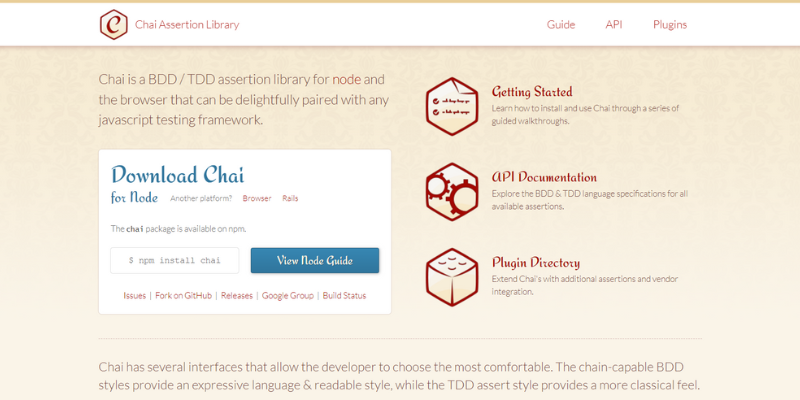
The Enzyme, an React testing framework can be used to develop assertions for functions, and also for components in the future.
Despite not being as popular as Jest or Mocha, Chai is becoming more popular among the best React testing frameworks. In most cases, Chai is used in conjunction with Mocha and Enzyme or Jest and Enzyme respectively.
Feature Highlights
- In addition to supporting Behavior Driven Development, it also supports Test-Driven Development.
- On GitHub, Chai has over 7.7k stars.
- Several interfaces are available.
- A JavaScript testing framework or library can easily be integrated with Chai.
Installation
Like Node's assert library, Chai is an assertion library. Testers find it much easier to test with it because it offers a multitude of assertions that they can run.
Node.js
Chai can be found on NPM. Type this command to install it:
$ npm install --save-dev chaiBrowsers
Use the chai.js file from the download if you want to use it in the browser, install via npm and use the chai.js file that's included within the download. For instance:
<script src="./node_modules/chai/chai.js"></script>#2 Jest
Many developers consider Jest to be one of the best React testing libraries or best React testing frameworks. Facebook is responsible for designing and propping it. Additionally, it supports TypeScript, Node.js, Angular, and Vue.js, along with React.
Testing React components with Jest is a popular practice at Facebook, used by Uber, Airbnb and other companies. Therefore, Jest is recommended by the React community as the preferred testing framework for React and React frontend testing.
It supports most JavaScript projects right from the start, notably create-react-app, NG, Vue, and even TS or Babel. With React, Jest's UI snapshot testing and complete API philosophy make a great combination.
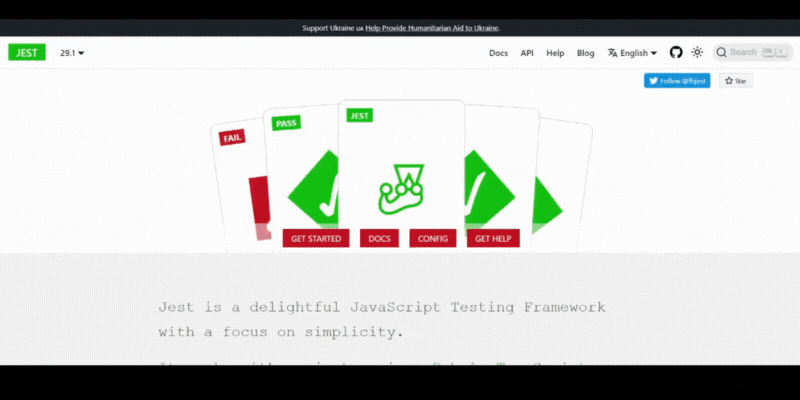
In addition to its performance advantages, process-based parallel testing is easy to use and offers the choice of giving priority to failed tests. Testing frameworks for React are probably most popular with Jest, with over 16M downloads per week.
Jest is an easy-to-use tool. There is little setup required, and it's available in Node Package Manager (NPM). Jest tests can be written by anyone who is familiar with JavaScript.
Feature Highlights
- On GitHub, it has 40.4k stars.
- It is free and open-source.
- Parallel testing is supported.
- As well as being fast, it also supports promises.
- Detailed documentation is provided.
Installation
An installation using yarn.
yarn add --dev jestAn installation using npm.
npm install --save-dev jest#3 Mocha
Using Mocha, you can test Node.js applications in any browser and with any assertion library, supporting asynchronous testing, test coverage reports, and assertion libraries.
In addition to being extremely configurable, the Mocha, an React testing library entitles the developer to select which tools they want to use to test their code, while also permitting you to incorporate or out most supporting libraries and tools.
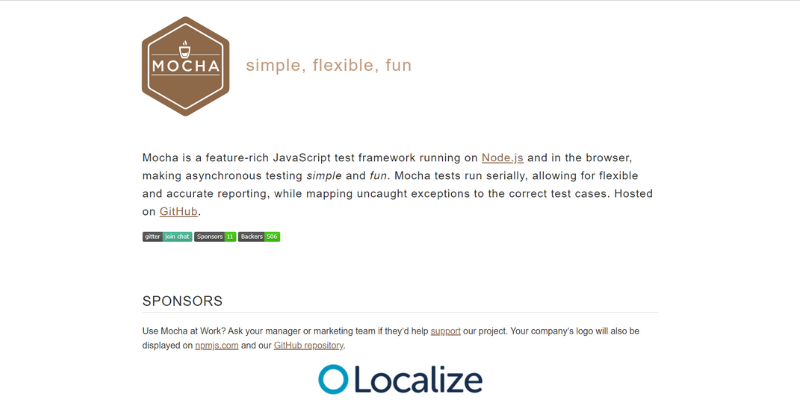
As with Jest and other frameworks, Mocha can also be combined with Enzyme, Chai, and other libraries for assertions, mocking, and so on when used with React.
Often, if advanced configurations are needed with a mature and rich toolset, some prefer to test their React apps as well.
However, this can also become a hassle as you will have to add more tools to your workflow to complete common tasks (like snapshots).
Feature Highlights
- On GitHub, Mocha has over 21.7k stars.
- Mocha has a lot of flexibility.
- Asynchronous testing is supported by Mocha.
- Servers and browsers can also be tested using it.
- With Mocha, generator support can be easily added.
Installation
With npm, install globally:
$ npm install karma --save-devYou can use these development dependencies in your project:
$ npm install karma-jasmine karma-chrome-launcher jasmine-core --save-dev#4 Karma
Karma does not support React testing frameworks or assertion libraries (compatible with Jasmine, Mocha, etc.). The HTTP server in which the test runner runs produces the HTML file for the test runner.
A JavaScript program can be executed in multiple real-time browsers with Karma. The purpose of this tool is to make it as easy as possible to write code and get information from your tests, without having to muck around with configuration.
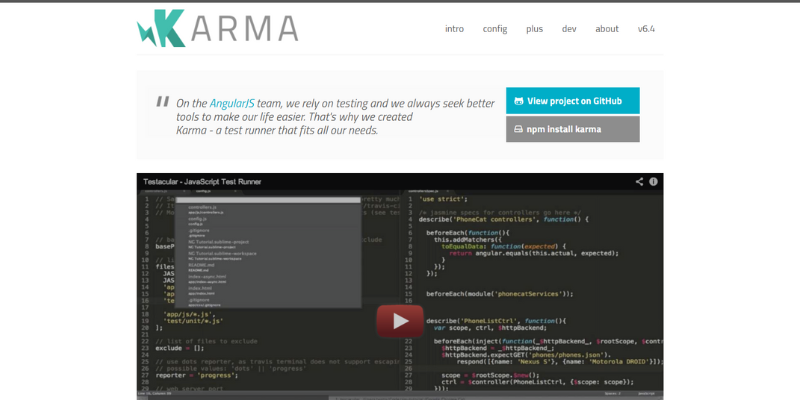
Testing can be run on real browsers and devices, such as mobile phones, tablets, and desktops, while the entire feedback loop takes place in your IDE. Karma also works with continuous deployment to Jenkins, Travis etc.
Feature Highlights
- The software is open-source.
- On GitHub, it has 11.8k stars
- Karma runs tests perfectly.
- Karma makes debugging easy.
- Continual integration is supported.
Installation
The Karma package runs on Node.js and is accessible via npm. If you want to install Karma (as well as all the plugins you need) locally in your project directory, you should follow the steps below.
Karma must be installed by:
$ npm install karma --save-devIf your project requires plugins, install them as follows:
$ npm install karma-jasmine karma-chrome-launcher jasmine-core --save-dev#5 Jasmine
Implying Jasmine as your test runner and BDD framework allows you to test all types of JavaScript applications. The user interface is tested on several devices, with different resolutions, both from a visibility and a response perspective.
Jasmine is an application testing framework for JavaScript based on Behavior Driven Development. A JavaScript framework is not required, nor does it rely on browsers, DOM, or any other JavaScript elements.
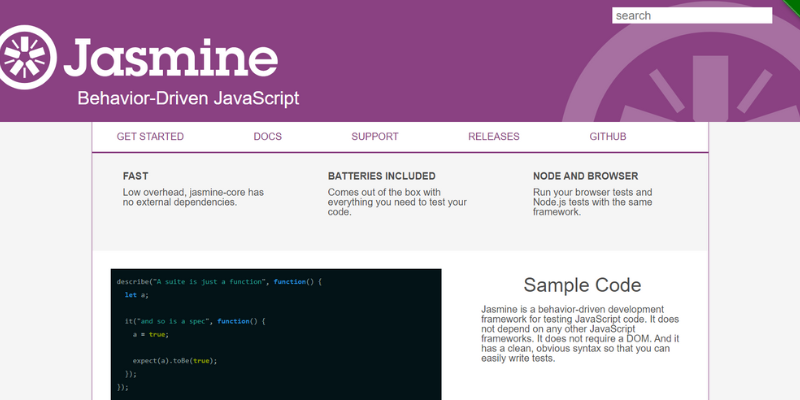
Many developers who use the Angular CLI love using Jasmine for testing their applications as well as React frontend testing. Generally, developers use it in collaboration with Babel and Enzyme to test React apps.
The CLI tool has traditionally been used with frameworks like Angular. In order to streamline this workflow, a dedicated helper util library was built.
You should also be aware that Jasmine does not provide snapshot tests, code coverage tools, parallelization (requires third-party tools), and native DOM manipulation (requires a third-party tool).
Feature Highlights
- DOM (document object model) is not necessary for Jasmine.
- It is helpful both for front-end and back-end testing.
- Community support and solid documents.
- On GitHub, Jasmine has over 561 stars.
Installation
The Jasmine framework employs behavior-driven development to test JavaScript code. There is no reliance on any other JavaScript framework.
For Node.Js
With npm, you can install Jasmine locally:
npm install --save-dev jasmineFor Browsers
Jasmine should be added to package.json using this,
npm install --save-dev jasmine-browser-runner jasmine-core
npx jasmine-browser-runner init#6 Enzyme
In particular, Enzyme's testing framework syncs up with Jest's testing framework quite frequently. Enzyme makes it possible for developers to easily test React components without having to install anything.
A leading developer and maintainer of the Enzyme framework is Airbnb. An enzyme is a testing utility, not a testing framework, that abstracts the rendering of components to make it easier to test their output.
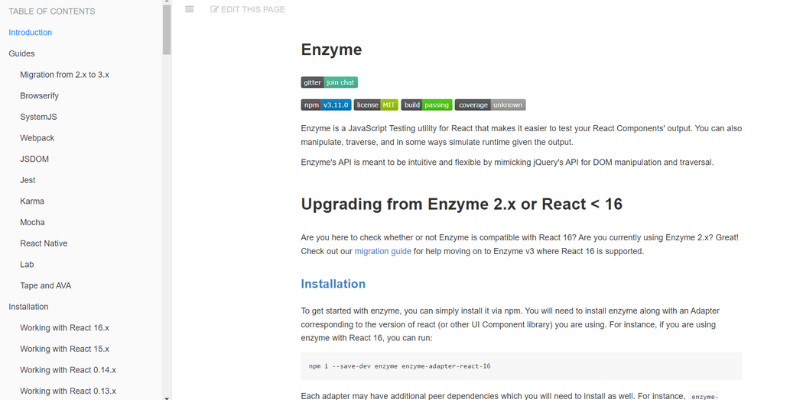
Additionally, the enzyme is employed by other React testing libraries alongside Jest, Mocha, and Karma. Among the companies that use the enzyme are Airbnb, Frontend, BlaBlaCar, and Kaidee.
A similar feature to JQuery's manipulation of DOM elements is Enzyme's ability to manipulate, traverse, and even pretend to be a runtime element.
In addition to rendering components, finding elements, and engaging with them, the tool is also quite useful in finding and engaging with them. The enzyme is compatible with Karma, Mocha, or other frameworks if you use Jest in conjunction with it.
Feature Highlights
- Shallow rendering is used in it.
- On GitHub, the enzyme has over 19.9k stars.
- Runs the full DOM rendering.
- You can access the business implementation of the components.
Installation
If you want to get started with enzyme, all you have to do is install it using npm. If you are using React (or another UI Component library), you will need to install enzyme along with an Adapter. The following instance shows how to use enzyme with React 16:
npm i --save-dev enzyme enzyme-adapter-react-16#7 React-Testing-Library
According to reports, 71 companies use React testing library to test their applications, including Graphy, Ze Delivery, Commercetools, Hivebrite, MPB, and Page Builder.
An extensive community of developers supports the React-testing-library, created by Kent C. Dodds. By simulating the user behavior in your tests, you can easily test the component.
This library provides a comprehensive set of React DOM testing utilities built around simulating real user action and workflow. Using React testing library, you can test React components.
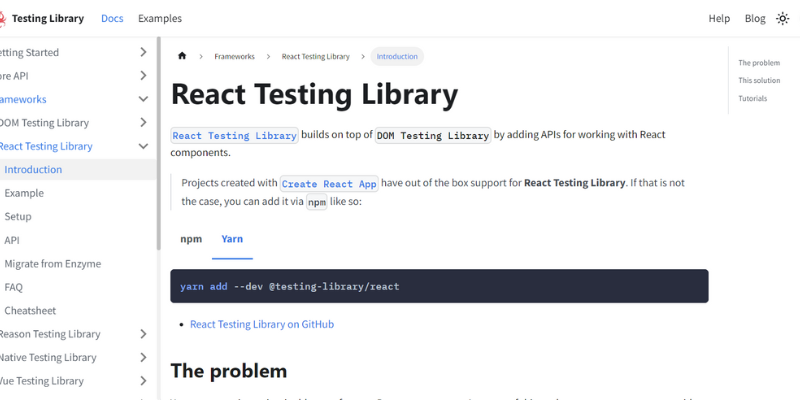
As an extension of react-dom, it makes use of test-utils and react-dom. Testing is done with DOM nodes rather than rendered components in the React testing library.
There are some limitations with this library, including that you cannot perform shallow rendering or access state-based information.
Feature Highlights
- On GitHub, the React testing library has over 17k stars.
- Vue, React, and Angular can be incorporated with it.
- DOM testing utilities are included.
- The React testing library allows you to easily replicate workflows and user actions.
- It is possible to test behavior using the React testing library.
Installation
npm installation
npm install --save-dev @testing-library/reactYarn installation
yarn add --dev @testing-library/reactA final shot
A React web application can be tested quickly with numerous unified and best React testing libraries. All of them have their benefits and drawbacks.
A number of best React testing frameworks are available. Each of them has unique features, benefits, and drawbacks. The following can be categorized as libraries or frameworks, while some are just functions that are used with libraries or frameworks seamlessly.
React testing is made easy with the Jest library. For better results and experience, it is frequently used in conjunction with Enzyme. React testing frameworks like Jasmine and Mocha are also popular with Enzyme.
React's modularity makes TDD easier. You can put this theory into practice without pain by selecting the right tooling, from components to integration and end-to-end testing.
To create a smooth yet flexible workflow that can adapt when upgrading, extending, and modifying your code, you need the right testing framework (e.g. Jest etc) coupled with the right assertion/manipulation libraries (e.g. Enzyme etc).
As a result of virtually isolating components from their projects (e.g. Bit etc), modularity and test-driven development are taken to an entirely new level.
React Performance Monitoring with Atatus RUM
Visualize React errors and performance issues influencing your end-user experience. With React performance monitoring of Atatus you can identify and resolve problems faster with in-depth data points that assist you in analyzing and resolving them.
Using Atatus, you can get an overview of how your customers experience your React app. Learn how to identify the root cause of a slow load time, route change, and more on the front end by identifying performance bottlenecks in the front end.
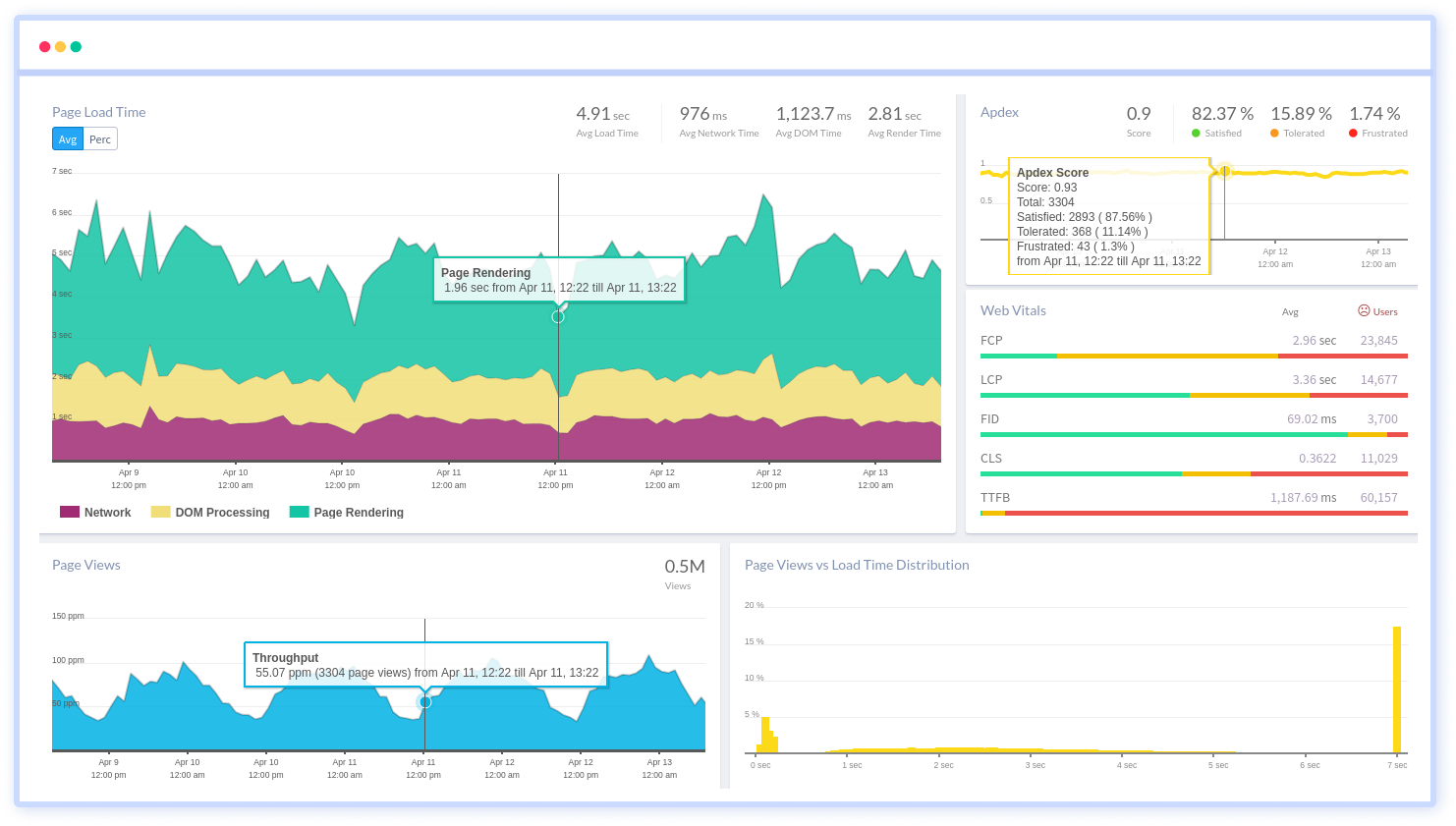
Ensure that your React app sends all XHR requests. Monitoring and measuring the response times and failure rates of XHR calls. Optimize AJAX request performance by identifying slow and failed calls. Analyze AJAX calls in real time based on the browser, the user, the version, the tag, and other attributes.
Identify the reasons behind bad front-end performance and slow page loading that are impacting your customers. Inspect individual users who are experiencing poor performance because of slow pages, React exceptions or a failing AJAX method.
Identify how your end users' experience is impacted by the network or geography. In addition to identifying slow React assets, long load times, and errors in sessions, session traces provide a waterfall view of the session.
Take a closer look at your React app performance with Atatus. To get started activate Atatus free-trial for 14 days!
#1 Solution for Logs, Traces & Metrics
APM
Kubernetes
Logs
Synthetics
RUM
Serverless
Security
More


